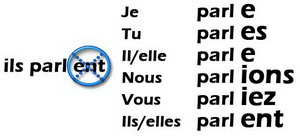Subjonctif ชื่อนี้หลอกหลอนคนเรียนภาษาฝรั่งเศสมากมายหลายคน อันที่จริง Subjonctif นั้นไม่ได้ยากเย็นอะไรนัก การกระจายกริยาก็มีทางลัดให้ ถ้าเดินตามโอกาสผิดพลาดก็จะน้อยลงมาก มาดูกันว่า Subjonctif มันเป็นอย่างไร
วิธีการทำ Subjonctif ใช้กริยาที่กระจายกับประธาน ILS ใน présent ตัดหางทิ้งแล้วเติมหางใหม่ที่เป็นลูกผสมระหว่าง présent กับ imparfait เคยบอกแล้วตั้งแต่ต้นว่า เวลากระจายกริยาใน Présent ให้ใส่ใจ nous และ ils เป็นพิเศษ nous เอาไปทำ imparfait ส่วน ils ก็เอามาทำ Subjonctif นี่แหละ
วิธีใช้ Subjonctif
1. หลังกริยาแสดงความปรารถนา ต้องการ คำสั่ง ขอร้อง แนะนำ
- désirerปรารถนา
- vouloirต้องการ
- souhaiterปรารถนา
- demanderร้องขอ
- ordonnerสั่ง
- recommanderแนะนำ
ตัวอย่าง
· Je souhaite que tu viennes.ฉันปรารถนาให้เธอมา
· Je demande que tu sois gentil. ฉันขอให้เธอทำตัวดี ๆ
· Je veux que vous lisiez à haute voix.ฉันอยากให้คุณอ่านออกเสียง
2. หลังกริยาแสดงความสงสัย คาดคะเน ไม่แน่ใจ เช่น douterสงสัย, ne pas croireไม่เชื่อว่า, ne pas penserไม่คิดว่า
ตัวอย่าง
· Je doute qu’il ne comprenne pas. ฉันสงสัยว่าเขาไม่เข้าใจ
· Je ne pense pas qu’ils soient en retard.ฉันไม่คิดว่าเขาจะมาสาย
· Je ne crois pas que ce soit vous.ฉันไม่เชื่อว่าจะเป็นคุณ
ระวังถ้าแน่ใจไม่ต้องใช้ Subjonctif
Je crois qu’il comprend.
3. หลังกริยาและสำนวนแสดงความรู้สึกต่าง ๆ เช่น regretterเสียใจ, craindreเกรงว่า, avoir peurกลัวว่า, être heureuxมีความสุขที่, être contentยินดีที่, être étonnéประหลาดใจที่ เป็นต้น
ตัวอย่าง
· Je suis heureuse que tu viennes.มีความสุขจังที่เธอมา
· Ils regrettent que je parte.เขาเสียใจที่ฉันต้องไป
· Ils ont peur que tu sois malade.เขากลัวว่าเธอจะไม่สบาย
4. หลังสำนวนต่อไปนี้
- Il faut queต้อง
- Il vaut mieux que จะดีกว่าถ้า
- Il est nécessaire que จำเป็นที่
- Il est important queสำคัญที่
- Il est utile queเป็นประโยชน์ที่
- Il est possible queเป็นไปได้ที่
- Il n’est pas sûr que ไม่แน่ใจว่า
- Il n’est pas vrai queไม่จริงที่
ตัวอย่าง
· Il faut que nous continuions à travailler.เราต้องทำงานต่อ
· Il est nécessaire que vous disiez la vérité à vos parents.มันจำเป็นที่คุณต้องบอกความจริงกับพ่อแม่
· On n’est pas sûr qu’il sache conduire.ไม่มั่นใจว่าเขาขับรถเป็น
· Il n’est pas vrai que ce soit lui, le voleur.ไม่จริงที่เขาจะเป็นขโมย
ระวัง
Il est certain queแน่ใจที่
Il est sûr queแน่ใจที่ + indicatif
Il est vrai queจริงที่
5. หลังสันธานต่อไปนี้ pour queเพื่อว่า, afin queเพื่อว่า, quoiqueแม้ว่า, bien queแม้ว่า, jusqu’à ce queจนกระทั่ง, avant queก่อนที่, à moins queเว้นไว้แต่ว่า
ตัวอย่าง
· Je t’aide pour que tu puisses gagner.ฉันช่วยเพื่อให้เธอชนะ
· Afin que tu sois à l’heure, je te prête mon réveille-matin.เพื่อที่เธอจะได้มาตรงเวลา ฉันให้เธอยืมนาฬิกาปลุก
· Quoiqu’il soit plus âgé, il est beau. แม้ว่าเขาจะอายุมากขึ้น แต่ก็ยังดูดี
· Sylvie a fait la cuisine avant que son enfant revienne. ซิลฟีทำอาหารก่อนลูกกลับมา
· Il boit jusqu’à ce qu’il n’y ait plus de vin. เขาดื่มจนกระทั่งไวน์หมด
การใช้ subjonctif เป็นเรื่องที่ค่อนข้างซับซ้อนสักนิด แต่ก็ไม่เกินความพยายาม คนฝรั่งเศสเองใช้ผิดก็ยังมี ดังนั้น อย่าไปวิตกจนเกินเหตุ หมั่นทบทวนบ่อย ๆ อย่างคนมีสติ...ผิดไม่บาป แต่ผิดแล้วต้องแก้ไขให้ถูก ก็เท่านั้น
Thanks to http://www.bonjourajarnton.com/index.php?lay=show&ac=article&Id=5355175
